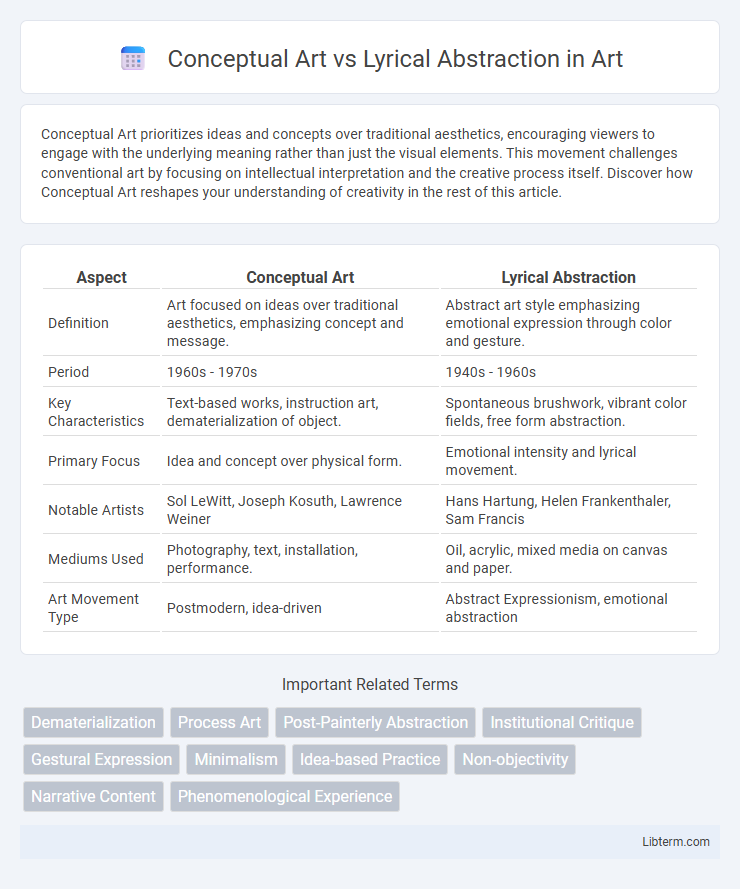Conceptual Art prioritizes ideas and concepts over traditional aesthetics, encouraging viewers to engage with the underlying meaning rather than just the visual elements. This movement challenges conventional art by focusing on intellectual interpretation and the creative process itself. Discover how Conceptual Art reshapes your understanding of creativity in the rest of this article.
Table of Comparison
| Aspect | Conceptual Art | Lyrical Abstraction |
|---|---|---|
| Definition | Art focused on ideas over traditional aesthetics, emphasizing concept and message. | Abstract art style emphasizing emotional expression through color and gesture. |
| Period | 1960s - 1970s | 1940s - 1960s |
| Key Characteristics | Text-based works, instruction art, dematerialization of object. | Spontaneous brushwork, vibrant color fields, free form abstraction. |
| Primary Focus | Idea and concept over physical form. | Emotional intensity and lyrical movement. |
| Notable Artists | Sol LeWitt, Joseph Kosuth, Lawrence Weiner | Hans Hartung, Helen Frankenthaler, Sam Francis |
| Mediums Used | Photography, text, installation, performance. | Oil, acrylic, mixed media on canvas and paper. |
| Art Movement Type | Postmodern, idea-driven | Abstract Expressionism, emotional abstraction |
Defining Conceptual Art: Ideas Over Objects
Conceptual Art emphasizes ideas and intellectual engagement rather than physical objects, challenging traditional art forms by prioritizing meaning over materiality. Artists like Sol LeWitt and Joseph Kosuth use text, instructions, and documentation to convey concepts, often rendering the tangible artwork secondary or obsolete. This movement redefines artistic value by focusing on the viewer's interpretation and the creative process itself, contrasting sharply with the emotive, gestural qualities of Lyrical Abstraction.
Understanding Lyrical Abstraction: Emotion in Gesture
Lyrical Abstraction emphasizes spontaneous, emotive gestures that convey the artist's inner feelings through fluid brushstrokes and dynamic forms. Unlike Conceptual Art, which prioritizes ideas and intellectual engagement, Lyrical Abstraction values the sensory and emotional experience evoked by color, texture, and movement. This approach highlights the expressive power of the artist's gesture as a direct channel for personal and emotional communication.
Historical Origins and Evolution
Conceptual Art emerged in the 1960s as a movement prioritizing ideas over aesthetic form, rooted in Duchamp's earlier readymades and influenced by Fluxus and Minimalism, emphasizing intellectual engagement and dematerialization of the art object. Lyrical Abstraction developed in the late 1940s and 1950s as a counter-movement to geometric abstraction, inspired by European Existentialism and Abstract Expressionism, focusing on free, spontaneous brushwork and emotional intensity. Both movements evolved through shifting cultural paradigms, with Conceptual Art challenging traditional art markets and institutions, while Lyrical Abstraction embraced personal expression and poetic sensibility.
Key Philosophies: Intellect vs Sensibility
Conceptual Art prioritizes intellect by emphasizing ideas, processes, and the dematerialization of the art object, challenging traditional aesthetics through critical thought and language. Lyrical Abstraction centers on sensibility, valuing spontaneous expression, emotional resonance, and the poetic use of color and form to evoke subjective experience. The philosophical divergence lies in Conceptual Art's cerebral critique of art's meaning versus Lyrical Abstraction's focus on sensory depth and affective engagement.
Major Artists and Influential Works
Conceptual Art emphasizes ideas over visual form, with major artists like Sol LeWitt, whose "Wall Drawings" redefine artistic authorship and process, and Joseph Kosuth, known for "One and Three Chairs," which challenges perceptions of representation. Lyrical Abstraction centers on expressive, spontaneous gesture and color, exemplified by artists such as Helen Frankenthaler, whose "Mountains and Sea" pioneered soak-stain techniques, and Sam Francis, noted for vibrant, fluid compositions that convey emotional intensity. Both movements significantly influenced contemporary art, with Conceptual Art reshaping art's purpose and Lyrical Abstraction advancing non-representational expression.
Techniques and Materials Compared
Conceptual Art emphasizes ideas over physical form, often employing mixed media, text, and found objects to challenge traditional artistic techniques and materials. Lyrical Abstraction relies on spontaneous brushwork and vibrant pigments, using oils, acrylics, and washes to create emotive, fluid compositions focused on personal expression. While Conceptual Art prioritizes concept and narrative through unconventional materials, Lyrical Abstraction highlights sensory experience with traditional painting tools enhanced by abstract improvisation.
Viewer Experience: Interpretation and Engagement
Conceptual Art emphasizes the primacy of ideas over aesthetic form, prompting viewers to engage intellectually through critical interpretation and reflection on the artwork's underlying message. Lyrical Abstraction prioritizes emotional resonance and sensory experience, encouraging audience members to connect intuitively with the fluidity of color, texture, and spontaneous gestures. The viewer's role shifts from passive appreciation to active meaning-making, shaped by the distinctive modes of engagement each movement fosters.
Impact on Contemporary Art Movements
Conceptual Art revolutionized contemporary art by emphasizing ideas over aesthetics, influencing movements like Minimalism and Performance Art with its focus on intellectual engagement and dematerialization of the art object. Lyrical Abstraction, with its emphasis on spontaneity and emotional expression through color and form, contributed to the revival of painterly approaches, impacting movements such as Neo-Expressionism and Color Field painting. Both movements challenged traditional art boundaries, fostering a diverse and experimental art landscape in the late 20th century.
Critical Reception and Debates
Conceptual Art faced critical debates centered on its emphasis on ideas over aesthetic form, challenging traditional art values and causing division among critics who questioned its artistic merit. Lyrical Abstraction received mixed reception, praised for its emotive freedom and color intensity yet criticized for perceived lack of structure and formal rigor compared to geometric abstraction. Both movements sparked intense discussions on the nature of art, representation, and the evolving boundaries between concept and expression in contemporary art criticism.
Lasting Legacy and Future Directions
Conceptual Art revolutionized contemporary art by prioritizing ideas over aesthetics, influencing movements like Installation Art and institutional critique, while Lyrical Abstraction reinvigorated emotional expression and spontaneity in painting, impacting Abstract Expressionism's evolution. The lasting legacy of Conceptual Art lies in its challenge to traditional art forms and expanded definitions, whereas Lyrical Abstraction's influence endures through its embrace of personal gesture and color harmony. Future directions suggest a fusion of conceptual rigor with lyrical spontaneity, encouraging artists to explore interdisciplinary approaches and immersive experiences.
Conceptual Art Infographic

 libterm.com
libterm.com